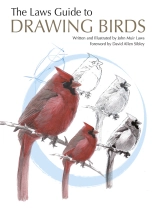John Muir Laws’s guide to drawing birds is itself winged, soaring between a devotion not only to art but also to the lives, forms, and postures of the birds themselves.
Here, artistic technique and the exquisite details of natural history intertwine, and drawing becomes the vehicle for seeing. As Laws writes, ‘To draw feathers, you must understand how feathers grow, overlap, and insert into the body. To create the body, you must have an understanding of the bird’s skeletal structure. To pose this skeleton, you must be able to perceive the energy, intention, and life of the bird.’
This how-to guide will perfect the technique of serious artists but also, perhaps more importantly, it will provide guidance for those who insist they can’t draw. Leading the mind and hand through a series of detailed exercises, Laws delivers what he promises: that ‘drawing birds opens you to the beauty of the world.’ An Audubon Book.
More journaling titles by John Muir Laws:
- The Laws Guide to Nature Drawing and Journaling
- How to Teach Nature Journaling
- The Laws Sketchbook for Nature Journaling
विषयसूची
Acknowledgements
Foreword by David Allen Sibley
Bird Drawing Basics
- The Joy of Drawing Birds
- Draw a Bird in Six Steps
- Posture, the First Line
- Proportion
- Head Position
- Angles
- Everything Follows Shape
- Step by Step: Warbler
- Step by Step: Sparrow
Mastering Bird Anatomy
- Songbird Bills
- Cranial Kinesis
- Feather Groups vs. Markings
- Step by Step: Drawing Head Details
- Turning Heads
- Head Angles
- Body Feathers
- Suggesting Feathers
- Feathers of the Chest
- Chest Patterns
- Back Feathers
- Wings and the Automatic Linkage System
- Spread Your Wings
- Wing Tricks
- Wing Proportions
- Step by Step: Drawing Wings
- Technical Points
- Suggesting Wing Detail
- Tail Shape and Structure
- Moving and Foreshortening Tails
- The Thigh Bone’s Connected to the …
- How to Balance Your Birds
- Understanding Bird Feet
- Simplifying Bird Feet
- Leg Position and Angle
- Bird Leg Details
- Windows of the Soul
- Iridescence
Details and Tips for Common Birds
- Birds of Prey
- Raptor Anatomy
- Raptor Body Feathers
- Step by Step: Peregrine Watercolor
- Drawing Waterfowl
- The Angles of Heads and Tails
- Duck Details
- Duck Heads
- Waterfowl in Motion
- Step by Step: Ruddy Duck
- Working with Waders
- Wader Heads
- Step by Step: Shorebird Value Study
- Hummingbird Helper
Bird in Flight
- Build a Flight Frame
- Angled Flight Frames
- Another Angle on Wings
- Wing Tip Tips
- Make a Flight Model
- Sketching Small Birds in Flight
- Underwing Anatomy
- Step by Step: Raven in Flight
Field Sketching
- Go Outside and Draw
- Field Sketching Is Not Field Guide Art
- Working in the Field
- Field Sketching Zen
- Drawing Moving Birds
- Birds in Habitat
- Travel Sketching
- Documenting Rare Species
Materials and Techniques
- Keys to Better Drawing
- Observing Light and Shadow
- Planes and Texture
- Using Negative Space
- Combining Shapes
- How to Show Depth
- A Few of My Favorite Things
- Fast Sketching Combinations
- A Portable Watercolor Palette
- Paper Selection
- Painting on Toned Paper
- Color Theory Heresy
- Reinventing the Wheel
- Using Colored Pencils
- Step by Step: Colored Pencil Warbler
- Step by Step: Mixed-Media Stellar’s Jay
- Watercolor Choices
- Watercolor Techniques
- Mixing Complementary Colors
- Step by Step: Mixed-Media European Starling
- Using Reference Material
Bibliography
List of Illustrations
About the Author
लेखक के बारे में
John Muir Laws is a naturalist, educator, and artist with degrees in conservation and resource studies, wildlife biology, and scientific illustration. His books include The Laws Field Guide to the Sierra Nevada, The Laws Guide to Drawing Birds, The Laws Guide to Nature Drawing and Journaling, and (with Emilie Lygren) How to Teach Nature Journaling, all published by Heyday. He is cofounder of the Wild Wonder Foundation, an organization encouraging nature connection through art and science. Visit his website at johnmuirlaws.com.
David Allen Sibley is an American naturalist. He is the author and illustrator of The Sibley Guide to Birds (and several other books about birds), as well as The Sibley Guide to Trees.












